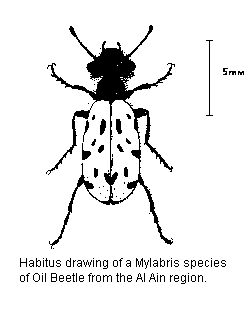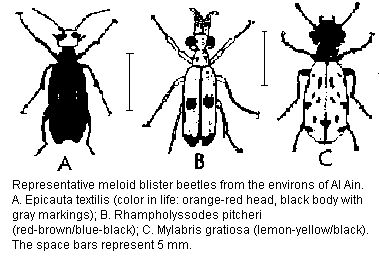by Michael P.T. Gillett
Synopsis of Project
During the two-year period January 1994 to December 1995, a program of work
will be undertaken in my spare time to study the poisonous oil or blister
beetles (Insecta: Coleoptera: Meloidae) of the Al Ain region. Extensive material
will be collected for (a) taxonomic identification of the tribes, genera and
species of meloids present in the area around Al Ain (including neighboring
areas of Oman), (b) establishment of a reference collection of meloids within
the UAE University, and (c) measurements of the body and haemolymph levels of
cantharidin (the principle poison of these beetles).
Those meloid species which represent the greatest threat to man (especially
children) will be identified and a campaign (newspaper, TV and poster) mounted
to educate the public about the potential dangers of contact with these beetles.
Additionally, because meloids are of potential agricultural importance both as
crop defoliators and as biological control agents for locusts and grasshoppers,
additional data will be collected on meloid-plant and meloid-Orthoptera
associations.
How Group Members Can Help
This is not a UAE University project, although the results obtained,
especially the collections made, will benefit that institution. Rather it should
be seen as an ENHG project to which all Group Members are invited to contribute
information and specimens. If, on your travels, you come across some meloid
beetles, I would be glad of the information as to number of insects, their
approximate size and color, and the locality where seen. If you can collect some
specimens in a suitable container, such as a small sealable plastic bag, or an
empty film canister (being careful to avoid handling them with bare hands!),
these will be most valuable if the following data can also be supplied:
- collector's name
- locality (map reference)
- prevailing weather conditions
- time of day and date
- details of collection (e.g. type of plant on which found etc.)
- other information such as abundance, mating behavior etc.
Any beetles collected should be placed in the freezer section of your fridge
and brought along to one of our regular meetings. Due credit for all such
specimens will be given in the written-up records of the project. How do you
recognize if an insect is a meloid? Unfortunately, this is not an easy question
to answer, as meloid beetles are quite diverse in size, coloration and
morphology! However, in the following section I have made an attempt, which,
with the illustrations, should point Group Members in the right direction. In
any case, if you make a mis-identification, I am always glad to receive and
record other beetles and insects.
Diagnosis of meloids
Unlike most desert beetles, meloid blister beetles are soft-bodied rather
than extensively armored. Often the wing cases (elytra) gape apart and in some
species they may be much shorter than the abdomen. The most distinctive feature,
however, is the head whish is not sunken into the thorax as in most beetles, but
is in fact globular and almost always wider than the anterior part of the
thorax. The base of the elytra is also always wider than the thorax. The
antennae may be quite simple (thread-like), clubbed or remarkably complex and do
not offer much help in identification. The tarsal joints (feet) of the front and
middle legs have five segments and those of the back legs only four, but several
other families of beetles have a similar arrangement. Many species will be
recognized by their bright coloration -- red or yellow with patterns of black
spots, bands and/or wavy lines. However, there are many species that have
different coloration such as metallic green, brown or black. The accompanying
drawings of actual beetles from the Al Ain region are taken from my field notes
for 1992 (a year of incredible abundance for meloids) and show the range of
variation found in these insects.
I am able to supply a copy of the complete project to anyone who is
interested in collaborating in this study.

